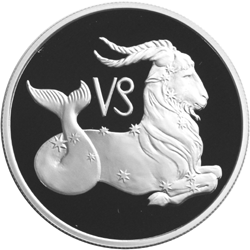Capricorn (astrology) facts for kids
Quick facts for kids Capricorn |
|
|---|---|
| Zodiac symbol | Sea goat |
| Duration (tropical, western) | December 21 – January 20 (2025, UT1) |
| Constellation | Capricornus |
| Zodiac element | Earth |
| Zodiac quality | Cardinal |
| Sign ruler | Saturn |
| Detriment | Moon |
| Exaltation | Mars |
| Fall | Jupiter |
Capricorn (♑︎) is the tenth astrological sign in the zodiac out of twelve total zodiac signs, originating from the constellation of Capricornus, the horned goat. It spans the 270–300th degree of the zodiac, corresponding to celestial longitude. Under the tropical zodiac, the sun transits this area from about December 21 to January 21 the following year, and under the sidereal zodiac, the sun transits the constellation of Capricorn from approximately January 16 to February 16. In astrology, Capricorn is considered an earth sign, negative sign, and one of the four cardinal signs. Capricorn is said to be ruled by the planet Saturn.
There appears to be a connection between traditional characterisations of Capricorn as a sea goat and the Sumerian god of wisdom and waters, Enki, who also had the head and upper body of a goat and the lower body and tail of a fish. Later known as Ea in Akkadian and Babylonian mythology, Enki was the god of intelligence (gestú, literally "ear"), creation, crafts; magic; water, seawater and lakewater (a, aba, ab).
In Hindu astrology, the equivalent of Capricorn is Makara, the Crocodile.
Cultural significance
In India, the zodiac sign of Capricorn is celebrated as the Makara Sankranti festival. The Indian astronomical calendar is not based on the western Gregorian or Julian date keeping system. The Gregorian calendar has fixed days in a year and does not accommodate difference in the actual solar year. Therefore, the festival is celebrated on either of 14 or 15 January every year, when, as per the Indian astronomical calendar, the Sun actually enters the Capricorn sign.
See also
 In Spanish: Capricornio (astrología) para niños
In Spanish: Capricornio (astrología) para niños



